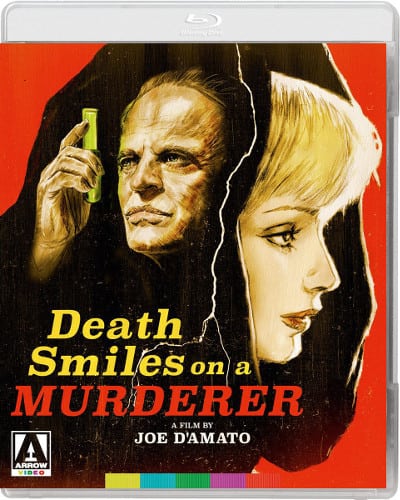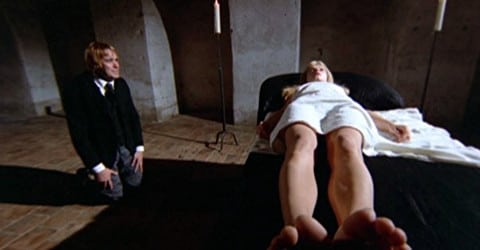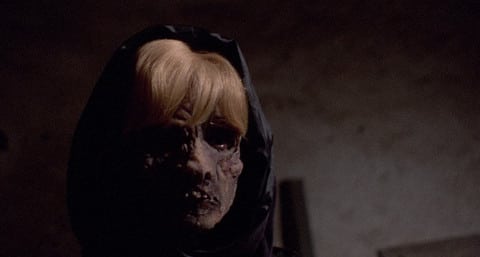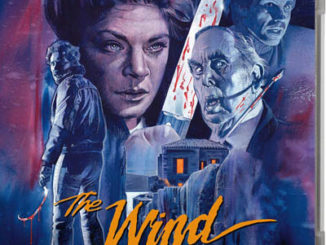Death Smiles on a Murderer (1973)
Directed by: Joe D'Amato
Written by: Claudio Bernabei, Joe D'Amato
Starring: Angela Bo, Ewa Aulin, Klaus Kinski, Sergio Doria
AKA LA MORTE HA SORRISO ALL’ ASSISSINO
Italy
AVAILABLE ON BLU-RAY: 21ST MAY, from ARROW VIDEO
RUNNING TIME: 85 mins
REVIEWED BY: Dr Lenera, Official HCF Critic
1906 Austria: a young woman flees a man who rapes her and runs into an older guy with whom she falls in love with. Three years later, a carriage bearing the same girl overturns, the driver is killed, and the woman wakes up with amnesia. Identified as Greta due to an amulet around her neck, she’s taken in by rich young couple Walter and Eva von Ravensbrück, both of whom fall in love with her. But why is the doctor who’s looking after her Dr. Sturges messing around with some medical formula to bring a corpse to life, and who is it who’s committing the odd murder in and around the house?….
Questions, questions, questions – you’ll be filled with them throughout this film and even by the time it finishes if you’re not paying attention. Even if you’re able to put the pieces together – and that’s not too easy to do because its story is told in a sometimes non-linear, even obtuse fashion – you my still ask yourself “how”? and “why”? with regard to a few details. One of several Italian Gothics made during the early 1970’s that brought in elements of the giallo to try to revive a declining-in-popularity form [I reviewed Arrow Video’s release of The Night Evelyn Came out of the Grave a while ago], Death Smiles On A Murderer is a decidedly arty venture, rich in dreamlike atmosphere, unusual editing and stylised camerawork, which for me makes it something of a surprise that the person credited with directing and co-writing this film is Joe D’Amato. D’ Amato is probably best known for the ‘video nasties’ The Anthropophagus Beast and Absurd, though I have fonder memories of sitting through his soft porn Eleven Days Eleven Nights trilogy as a teenager [so what, I was privileged to be able to hire out anything I wanted from my local video shop, they just didn’t seem to care]- again – and again – but enough about that. He’s more known as a sleaze merchant than a good filmmaker, but Death Smiles On A Murderer may surprise you with its quality and certainly with its artistic inclinations. It certainly surprised me and may have caused me to re-evaluate this director whom I’d previously placed scarcely higher than Jess Franco. Maybe Arrow or a similar distributor will bring out some more of his work? But in the meantime the very curious, if occasionally frustrating, Death Smiles On A Murderer certainly has a great deal to interest the viewer.
The script is credited to D’Amato, Romano Scandariato and Claudio Bernabei, though the latter was said to just be a typist by D’Amato, who on the credits of this film actually goes under his real name Aristide Massaccesi. For the first time in his career, the man was actually proud of a film he was making and gave up trying to hide his identity, though soon after this he chose the nom de plume Joe D’Amato which is what he became best known as. The story is credited to D’Amato, which Scandariato said was “more or less one page”. The first draft was written as a bit more large scale, but when the film was given a low budget of 150 million lire certain things had to changed or be cut out – which may partly explain why two subplots are drastically cut short [but then again it may not]. The work of Edgar Allan Poe, including a person being buried alive by a brick wall, and Sheridan La Fanu’s oft-filmed Carmilla seem to have been major influences. It was shot under the working title of Seven Strange Corpses [7 strani cadaveri] at Rome’s Elio Studios and two nearby villas. Some scenes not in the script were improvised on set, including one where Luciano Rossi was attacked by a cat. D’Amato achieved his desired effect by throwing the cat against Rossi’s face. Partly because distributors Florida Cinematografica carried little clout, the film was released to weak business at the box office and received its American release on TV under the title of Death Smiles At Murder.
So we open with a man crying over the body of his dead lover, saying he’s lost his one true love, but then we find out that she was his sister, and then any sympathy for him is lost when a flashback shows him raping her – though D’ Amato shows some commendable restraint in cutting away from the act very quickly. Cut to the two of them in bed, and he says that he’s going to take her away, but then we see her fleeing from him outside first in jest, then in reality before encountering and falling for another man in a strange montage over which one of those achingly beautiful theme tunes you often get in Italian films of the time plays. You’d swear it was by Ennio Morricone [there’s even a wordless female vocal part from Morricone’s frequent collaborator Edda Del ‘Orsa] or Carlo Savina, though it’s actually by Berto Bisano, a composer I hadn’t even heard of – and I thought I knew my film music, and especially of this kind of movie. Anyway, we now cut to a carriage hurtling along, and soon its passenger winds up in the house of the von Ravensbrücks not remembering a thing while the driver is bloodily killed by the carriage’s crash. I was expecting more back story to appear soon as flashbacks to the main ‘story’, but this film doesn’t give much more to you until near the end, a brave device since allowing us to know more of Greta’s sad background and her exact nature may have allowed us to have more sympathy for her. The synopsis released with this film reveals much of this so if you decide to buy this film, I would recommend that you don’t read the stuff on the back cover and go in without knowing so much, especially as I’m certainly trying my best not to reveal too spoilers!
So Greta, obviously fleeing a horrific life, soon finds herself in another one. It’s perhaps not a big deal that Walter has the hots for her, nor even that his wife Eva is jealous of their closeness not because he’s cheating on her but because she fancies her too. At one point she tries to drown her in the bath but somehow it all turns into a lesbian love scene. Well, it’s still a D’ Amato film. Meanwhile Inspector Dannick really has his work cut out for him in trying to work things out as does the viewer, and Dr. Sturges has found some formula to revive the dead – and it’s here where I feel I have to reveal the most disappointing thing about the film. Despite being second billed, the one and only Klaus Kinski only has a few scenes and exits proceedings nearly half way through – not that I’ll forget for some time the bit where he sticks a pin through Greta’s eyeball for no apparent reason, and she then shows no sign of this in the next scene! Elsewhere somebody is committing bloody murders, and the extreme shots of gore are kind of funny at times – for example there’s a razor slashing in which only after two or three slashes the victim’s face is covered in the red stuff. The cat attack goes on for a whole minute and the fakery which takes over will probably eventually inspire laughter. Eventually Eva murders Greta, and her father turns up to the funeral, and he’s….well, that’s it in terms of story I’m going to reveal.
Do things end up making sense? I guess they mostly do if you allow for the film to take place in the world of the supernatural, but many will still be left wondering about some things, and even I wondered about why we had scenes in which a servant maid was haunted by one of the other characters, as this goes nowhere. I guess we’re intended to think of the powerful evil of this character. And the final scene really is bonkers. I can’t figure out if it’s just intended as a silly final scare or indicative of a recurring nightmare one character could be trapped in – and that’s not the only part of this film that reminded me of the same year’s Lisa And The Devil, Mario Bava’s masterpiece and a film that I adore so much that I can’t believe that I’m mentioning something from Joe D’Amato in the same breath. Bava’s Kill Baby Kill also seems an influence. D’ Amato does stumble on a few occasions, in particular failing to make the most of the more potentially exciting scenes in this film, and nor does Bisano who sticks to slow musical material rather than giving us some action-type cues. There are two seemingly poor dance sequence in which no attempt seems to have been made to make it look as if the three musicians we see are playing what we hear on the soundtrack, though actually the first one does briefly show a record spinning so I suppose it’s forgiven. In a way it’s consistent with the way this film constantly shows something and then something else that alters our perception. The cinematography – by D’ Amato himself – is quite something. Okay, you get lots of those zooms that even Bava loved doing for a while, but you also get frequent odd angles, close-ups [a funeral scene is played out mostly in extreme close-ups of the guests] and POV [a surprising amount of shakycam here]. One scene has a hand held camera shooting with a fish eye lens go backwards as Greta runs through a forest towards the viewer being pursued. Some play out in hazy, slight slow motion and with no dialogue, just the score to help tie things together, while the music is essential in linking together some seemingly rather random montages. Points of view change frequently. It’s all quite free-form.
The use of electronic instruments in places is odd – but it works – I think. The score does seem to repeat the same two or three pieces over and over again though. And there’s some rather weak ‘face of a decomposed corpse’ make up that really doesn’t look very good at all [it’s a shame that stills of this movie seem to be rather limited]. The scenes involving it look like they may have inspired bits in Ghost Story. Ewa Aulin is somewhat wooden, but then I wondered if she was deliberately playing her role as a kind of blank canvass. Luciano Rossi as Frank is quite terrifying even though he has little screen time. Looking for all the world that it takes place in the 1970’s with little attempt to evoke its period setting, Death Smiles On A Murderer might be a little careless in a few aspects, especially with regard to its plot – but then I don’t think D’ Amato was going for coherency in the first place. Instead, he seems to have been attempting something akin to the druggy, surreal nightmare feel that Dario Argento and Lucio Fulci took to high levels a few years later, perhaps peaking with Suspiria and The Beyond respectively. I’m still not going to claim that D’ Amato was actually some major unrecognised master of cinema, but it does seem that he really was trying to do something a bit different with this film and after watching it I’m surprised that it isn’t more often held up as a notable work in its genre. And it really does have a Poe feel to it – and I’m not just saying that because of things like the cat [siamese, not black] that slinks around and the masked ball where a mysterious guest turns up.
Rating: 









The restoration of Death Smiles On A Murderer has a few minor blemishes here and there, and the outdoor scenes tend to look better than the indoor ones, but it’s still a fine presentation with plenty of detail. I compared portions of the Italian and English language tracks and the Italian track as expected turned out to be the more natural-seeming one, but the English one isn’t bad as these things go, reasonably smooth and with decent voice work – though for some reason it’s a lot quieter than the Italian track.
The great Tim Lucas provides another one of his densely packed audio commentaries. In fact, I’d say this was one of his best I’ve heard in a while. There’s obviously not a huge amount of background information on this movie, but he still comes up some interesting stuff like one character in the film being actually played by someone different to what it says on the credits. He pays close attention to how nearly every scene is shot and how the story is constructed in scholarly, yet easily understandable analysis. He even tries to make sense of one of the stranger sub plots. Lucas was obviously the perfect person to talk about this movie and he comes up trumps.
D’Amato Smiles on Death is a five minute interview with the director from 1999. I’m unable to find out where it comes from, and it’s very brief, but it’s nice to see D’Amato being pleased with the film and talking about Kinski who was, surprisingly, very professional to work with according to D’ Amato. He also says how another cast member went insane! All About Ewa runs 42 minutes and has Aulin go through her entire movie career along with some biographical background. It seems that pretty much all the films she’s made are unusual and certainly seem interesting, and, while at times she struggles to remember details on a specific project, she’s frank, warm company, and at the end appears to be genuinely humbled and greatful for the chance to talk about what she’s done. And finally we have the 21 minute Smiling on the Taboo: Sex, Death and Transgression in the horror films of Joe D’Amato in which Kat Ellinger discusses the way in which D’Amato liked to combine sex and horror and frequently broke taboos, as well as listing his many similarities to Jess Franco. It will probably leave you wanting to check out titles like Emmanuelle And The Last Cannibals – if only for a minute.
A very interesting Italian horror indeed which may baffle but which will certainly not bore, along with some fine special features – the Doc has to recommend this release from Arrow Video to all lovers of the bizarre and the creepy!
DETAILS
*Brand new 2K restoration from the original camera negative
*High Definition Blu-ray (1080p) presentation
*Original Italian and English soundtracks
*Uncompressed Mono 1.0 PCM audio
*Newly translated English subtitles for the Italian soundtrack
*Optional English subtitles for the deaf and hard of hearing for the English soundtrack
*New audio commentary by writer and critic Tim Lucas
*D’Amato Smiles on Death, an archival interview in which the director discusses the film
*All About Ewa, a newly-filmed, career-spanning interview with the Swedish star
*Smiling on the Taboo: Sex, Death and Transgression in the horror films of Joe D’Amato, new video essay by critic Kat Ellinger
*Original trailers
*Stills and collections gallery
*Reversible sleeve featuring original and newly commissioned artwork by Gilles Vranckx
*FIRST PRESSING ONLY: Collector’s booklet featuring new writing on the film by critic Stephen Thrower and film historian Roberto Curti








Be the first to comment